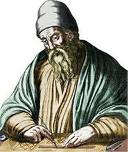Euclid
Introduction to Euclid
One of the towering figures in the mathematics of the ancient world was Euclid of Alexandria (325 B.C.E.-265 B.C.E.). He has had an incisive effect on human thought.
Euclid wrote a treatise (consisting of thirteen Books)-now known as Euclid’s Elements-which has been continuously in print for over 2000 years and has been through myriads of editions.
As often happens with scientists and artists and scholars of immense accomplishment, there is disagreement, and some debate, over exactly who or what Euclid actually was. The three schools of thought are these:
Euclid was an historical character
Euclid was the leader of a team of mathematicians working in Alexandria
Euclid was not historical character at all. In fact “Euclid” was a nom de plume-an allonym if you will-adopted by a group of mathematicians working in Alexandria
Most scholars today subscribe to the first theory-that Euclid was certainly a unique person who created the Elements. What is important about Euclid’s Elements is the paradigm it provides for the way that mathematics should be studied and recorded. He begins with several definitions of terminology and ideas for geometry, and then he records five important postulates (or axioms) of geometry. A version of these postulates is as follows:
P1 Through any pair of distinct points there passes a line.
P2 For each segment and each segment there is a unique point E (on the line determined by A and B) such that B is between A and E and the segment is congruent to
P3 For each point C and each point A distinct from C, there exist a circle with center C and radius CA.
P4 All right angles are congruent.
These are the standard four axioms which give our Euclidean conception of geometry. The fifth axiom, a topic of intense study for two thousand years, is the so-called parallel postulate (in Playfair’s formulation):
P5 For each line l and each point P that does not lie on l there is a unique line m through P such that m is parallel to l.
A number of other books by Euclid survive until now. These include Data (which studies geometric properties of figures), On Divisions (which studies the division of geometric regions into sub regions having areas of a given ratio), Optics (which is the first Greek work on perspective), and Phaenomena (which is an elementary introduction to mathematical astronomy).
The Ideas of Euclid
Here we concentrate on Euclidean geometry. In the present text, we are only scratching the surface. We use the fundamental notion of congruence. In particular, two triangles are congruent if their corresponding sides and angles are equal in length. There are a variety of ways to check that two triangles are congruent:
If the two sets of sides may be put in one to one correspondence so that corresponding pairs are equal, then the two triangles are congruent. We call this device “side-side-side” or SSS.
If just one side and its two adjacent angles correspond in each of the two triangles, so that the two sides are equal and each of the corresponding angles is equal, then the two triangles are congruent. We call this device “angle-side-angle” or ASA.
If two sides and the included angle correspond in each of the two triangles, so that the two pairs of sides are equal, and the included angles are equal, then the two triangles are congruent. We call this device “side-angle-side” or SAS
Theorem 1.1
Let ∆ABC be an isosceles triangle with equal sides and. Then the angles ∠B and ∠C are equal.
Proof!
Corollary 1.1
Let ∆ABC be an isosceles triangle as in the preceding theorem. Then the median from A to the opposite side BC is also perpendicular to BC.
Proof!
Theorem 1.2
Let l and m be parallel lines, as in figure 3. Let p be a transverse line which intersects both l and m. Then the alternating angles α and β (as shown in the figure) are equal.
Corollary 1.2
Let lines l and m be parallel lines as in the theorem, and let p be a transversal. Then the alternating angles αᶦ and βᶦ are equal. Also αᶦᶦ and βᶦᶦ are equal.
Proof!
Theorem 1.3
Let ∆ABC be any triangle. Then the sum of the three angles in this triangle is equal to a half-line (i.e. to 180⁰).
Proof!
Corollary 1.3
Let ∆ABC be any triangle and let be an exterior angle (see figure 4). Then equals the sum of the other two interior angles α and β.
Proof!







Leave a comment